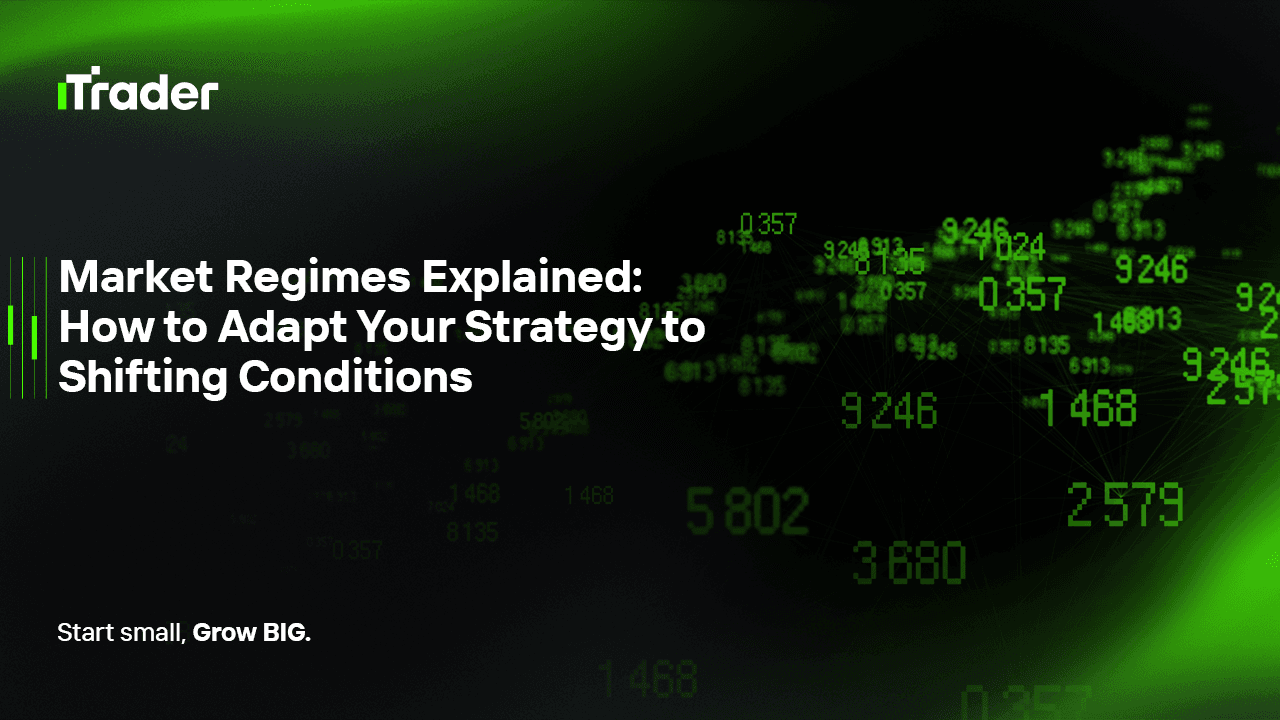2025-09-29
In the Forex market, stable and predictable environments are rare. Exchange rates can fluctuate sharply over short periods, while at other times, they may stagnate without any clear direction. In some phases, macroeconomic factors dominate price action; in others, technical dynamics take the lead. All of this directly affects the performance of trading strategies: what works well in one environment may underperform or even fail in another.

For prop traders, understanding market regimes and adjusting strategies accordingly is not merely a question of profit maximization. It’s a critical factor in passing evaluations, managing drawdowns, and securing funding.
This blog explores what market regimes are, how to identify them, how to adjust strategies when conditions shift, and why this adaptive ability is essential in a prop trading environment.
A market regime refers to the dominant structural and behavioral characteristics of the market over a specific period. Each trading strategy tends to perform best under a particular set of conditions. When the regime changes, performance deterioration is common if the strategy is not adapted accordingly.
Market regimes can be categorized in various ways, but the most common classifications are based on four main dimensions:
Identifying the prevailing regime provides the foundation for deciding which strategies to deploy, how to size positions, and when to stand aside.
Market regimes should not be identified by intuition alone. Using objective metrics allows traders to systematically classify conditions and adjust accordingly. The following are commonly used tools.
Rising volatility often calls for smaller position sizing or wider stop placement to avoid unnecessary whipsaws.
Most strategies are overfitted to a particular environment during backtesting. Parameter settings that work well in one regime often break down when conditions shift. This leads to several common issues:
When regimes shift, traders should not blindly abandon their systems. Instead, they should apply structured adaptation methods, including rule-based adjustments, volatility-sensitive sizing, filtering, or switching between strategy clusters.
This involves setting clear, objective rules for determining the current regime and activating specific strategies accordingly. For example:
This approach provides a systematic way to align strategies with prevailing conditions.
Adjusting position size according to volatility is one of the most effective ways to control drawdowns. By linking position size to ATR or historical volatility, traders can reduce risk during turbulent periods and scale up during stable phases.
This involves running multiple strategies in parallel and dynamically allocating capital based on regime. For example:
More advanced methods include:
These approaches enable a higher degree of automation in adapting strategies to changing environments.
Theory alone is not enough. To benefit from regime analysis, traders must integrate it into their daily and systematic processes.
Keep a daily log that maps observed market regimes to strategy performance. Over time, this creates a clear picture of which strategies work best in which conditions. It also improves your situational awareness as a trader.
Instead of relying on static backtests, use Walk-Forward Analysis to periodically re-optimize strategy parameters on rolling windows. This reduces overfitting and maintains alignment with current market regimes.
Monitor regime indicators in real time and adjust position sizing, entry filters, or strategy activation accordingly. For prop traders, this is essential to staying within daily and overall drawdown limits.
Prop firms evaluate traders primarily on consistency and risk control. Many traders fail evaluations not because their strategies are bad, but because they don’t adapt when market conditions change.
A trader with strong regime adaptation capabilities can:
In short, regime adaptation transforms a trader from someone who merely “has a good strategy” into someone who can survive, adapt, and thrive in any market.
Market regimes represent the underlying structure of price behavior. Ignoring them and applying a fixed strategy mechanically leads to performance decay, drawdowns, and potential funding failures.
Traders who use objective regime identification metrics and implement systematic adjustments—through rule-based switching, volatility-sensitive sizing, strategy stacking, or machine learning—gain a critical advantage. They:
Strategy ≠ Success.
Strategy × Market Regime Alignment = Sustainable Performance.
© 2025 iTrader Global Limited|会社登録番号:15962
iTrader Global Limitedは、コモロ連合のアンジュアン自治島ムツァムドゥのHamchakoに所在し、コモロ証券委員会によって認可・規制を受けています。ライセンス番号は L15962/ITGL です。
iTrader Global Limitedは「iTrader」の商号で運営しており、外国為替取引業務を行う許可を受けています。会社のロゴ、商標、ウェブサイトはすべて iTrader Global Limited の専有財産です。
iTrader Global Limitedの他の子会社には、iTrader Global Pty Ltd(オーストラリア会社登録番号(ACN):686 857 198)が含まれます。 この会社は、Opheleo Holdings Pty Ltd(オーストラリア金融サービスライセンス(AFSL)番号:000224485)の認可を受けた代表者(AFS代表番号:001315037)です。登録住所は Level 1, 256 Rundle St, Adelaide, SA 5000 です。
免責事項: この法人は、本ウェブサイト上で取引される金融商品の発行者ではなく、それらに対して責任を負いません。
リスク警告: 差金決済取引(CFD)は、レバレッジにより資本の急速な損失リスクが高く、すべての利用者に適しているとは限りません。
ファンド、CFD、その他の高レバレッジ商品を取引するには、専門的な知識が必要です。
調査によると、84.01%のレバレッジ取引者が損失を被っています。取引を開始する前に、リスクを十分に理解し、資金を失う可能性があることを認識してください。
iTraderは、レバレッジ取引によるリスク、損失、またはその他の損害について、個人または法人に対して一切の責任を負わないことを明言します。
利用制限: iTraderは、法律、規制、または政策によりこのような活動が禁止されている国の居住者を対象として、本ウェブサイトやサービスを提供していません。